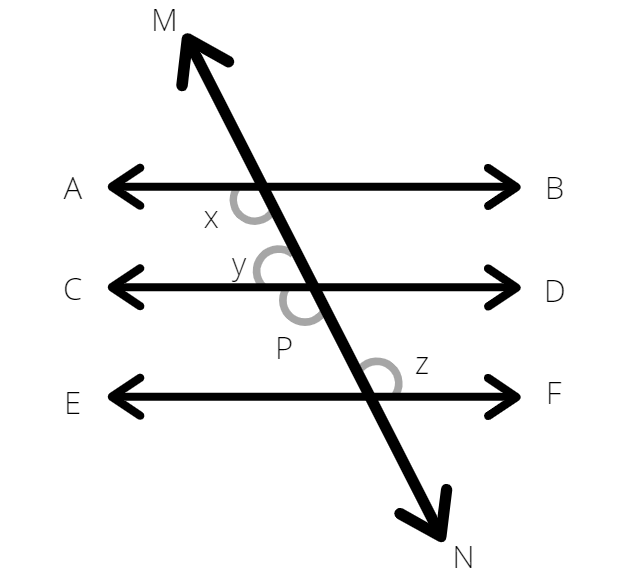
In fig if AB$||$CD, CD$||$EF and $y:z = 3:7$ find $x$


Answer
549k+ views
Hint: This sum involves application of properties of lines. The student has to make use of the properties like Corresponding Angles, Alternate Angles and sum of interior angles on the same side of the transversal is ${180^ \circ }$. This sum is extremely to solve and should involve no margin of error.
Complete answer:
From the figure we can see that it is given $\dfrac{y}{z} = \dfrac{3}{7}$
$\therefore y = \dfrac{3}{7}z$
Let $\angle CON = P$
Given CD$||$EF,
We can Say that $P = z$, Since they are Alternate Interior Angles
Also from the figure we can say
$\Rightarrow$ $y + P = {180^ \circ }$ Using the property i.e. sum of interior angles on same side of transversal is ${180^ \circ }$.
Now we can say that
$\Rightarrow$$y + z = {180^ \circ }$,
Also we know,
$\therefore y = \dfrac{3}{7}z$,
$\Rightarrow$$\dfrac{3}{7}z + z = {180^ \circ }$
$\therefore z = \dfrac{7}{{10}} \times {180^ \circ } = {126^ \circ }$
Putting $z = {126^ \circ }$,we get the value of $y$
$\therefore y = \dfrac{3}{7} \times 126 = {54^ \circ }$.
Also we can say that
$\Rightarrow$ $x + y = {180^ \circ }$,
Using the property i.e. sum of interior angles on the same side of transversal is ${180^ \circ }$.
$\therefore x = {180^ \circ } - {54^ \circ }$
$\therefore x = {126^ \circ }$
Note: It is important to note that the sums on geometry can be solved only if the student is well versed with the properties of the figures. Also sometimes the corollary of the properties can be used to solve the problems, so it is important to thoroughly study the properties.
Complete answer:
From the figure we can see that it is given $\dfrac{y}{z} = \dfrac{3}{7}$
$\therefore y = \dfrac{3}{7}z$
Let $\angle CON = P$
Given CD$||$EF,
We can Say that $P = z$, Since they are Alternate Interior Angles
Also from the figure we can say
$\Rightarrow$ $y + P = {180^ \circ }$ Using the property i.e. sum of interior angles on same side of transversal is ${180^ \circ }$.
Now we can say that
$\Rightarrow$$y + z = {180^ \circ }$,
Also we know,
$\therefore y = \dfrac{3}{7}z$,
$\Rightarrow$$\dfrac{3}{7}z + z = {180^ \circ }$
$\therefore z = \dfrac{7}{{10}} \times {180^ \circ } = {126^ \circ }$
Putting $z = {126^ \circ }$,we get the value of $y$
$\therefore y = \dfrac{3}{7} \times 126 = {54^ \circ }$.
Also we can say that
$\Rightarrow$ $x + y = {180^ \circ }$,
Using the property i.e. sum of interior angles on the same side of transversal is ${180^ \circ }$.
$\therefore x = {180^ \circ } - {54^ \circ }$
$\therefore x = {126^ \circ }$
Note: It is important to note that the sums on geometry can be solved only if the student is well versed with the properties of the figures. Also sometimes the corollary of the properties can be used to solve the problems, so it is important to thoroughly study the properties.
Recently Updated Pages
Why are manures considered better than fertilizers class 11 biology CBSE

Find the coordinates of the midpoint of the line segment class 11 maths CBSE

Distinguish between static friction limiting friction class 11 physics CBSE

The Chairman of the constituent Assembly was A Jawaharlal class 11 social science CBSE

The first National Commission on Labour NCL submitted class 11 social science CBSE

Number of all subshell of n + l 7 is A 4 B 5 C 6 D class 11 chemistry CBSE

Trending doubts
What is meant by exothermic and endothermic reactions class 11 chemistry CBSE

10 examples of friction in our daily life

One Metric ton is equal to kg A 10000 B 1000 C 100 class 11 physics CBSE

1 Quintal is equal to a 110 kg b 10 kg c 100kg d 1000 class 11 physics CBSE

Difference Between Prokaryotic Cells and Eukaryotic Cells

What are Quantum numbers Explain the quantum number class 11 chemistry CBSE




